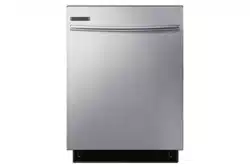Documents: Go to download!
User Manual
- User Manual - (English, French)
- Installation Guide - (English)
User manual Dishwasher
Using your dishwasher
DW80M3021 Series

| 1 POWER | When you press the POWER button, the Cycle On light for the most recently started cycle turns on. When the selected cycle is complete, the dishwasher powers off automatically. |
| 2 Cycle Selector | Select the appropriate wash cycle depending on the soil level of your dishes. After you select a cycle, the cycle on light for that cycle lights up. |
| 3 Hi-Temp Wash | Raises the main wash temperature to improve cleaning for loads containing tough, baked-on food. |
4 Sanitize /  (Control Lock) (Control Lock) |
The temperature rises to 163 ˚F (73 ˚C) in the final rinse cycle for high temperature sanitization. If you select the Sanitize option, the “Sanitize” lamp blinks when the water temperature reaches the sanitary temperature (over 155 ˚F (68 ˚C)), and then remains illuminated until the Sanitize option ends. When you press the POWER button, the “Sanitize” lamp turns off. The Normal cycle with the Sanitize option selected is NSF certified.
Control Lock allows you to lock the buttons on the control panel so children cannot accidently start the dishwasher by pressing the buttons on the panel. To lock and unlock the buttons on the control panel, hold the Sanitize button down for three (3) seconds when power is On. |
| 5 Display |
Displays cycle time and remaining hours and minutes, Delay Start hours, and Information codes. If a problem occurs during operation, an information
|
| 6 Delay Start |
Delay a cycle for up to 24 hours in one-hour increments. To increase the delay start time, press or hold the Delay Start button. The hour displayed indicates the time at which the wash will start.
|
| 7 START |
To start a cycle, press the START button before closing the door. *Cancel: To cancel a currently running cycle and drain the dishwasher, press and hold the START button for three (3) seconds. Once the dishwasher is reset, select a cycle and option, and then press START to restart the dishwasher. |
 You can select options (Hi-Temp Wash, Sanitize) before starting a cycle. If you change the cycle after selecting an option, the original cycle is reset.
You can select options (Hi-Temp Wash, Sanitize) before starting a cycle. If you change the cycle after selecting an option, the original cycle is reset.
 To prevent the touchpad from losing response sensitivity, follow these instructions:
To prevent the touchpad from losing response sensitivity, follow these instructions:
- Touch the center of each keypad using one finger. Do not push.
- Clean the touch control’s surface regularly with a soft, damp cloth.
- Be careful not to touch more than one touch key pad at a time, except as directed.
 When you pause a cycle by opening the door during operation, press the START button before closing the door to continue the cycle.
When you pause a cycle by opening the door during operation, press the START button before closing the door to continue the cycle.
Push door firmly closed within 3 seconds of pressing START button.
If the door is not closed within 3 seconds, the cycle will not start.

CYCLE SELECTOR
DW80M3021 Series
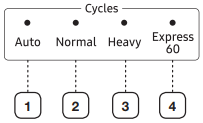
| 1 Auto | This cycle detects the level of soil and automatically initiates the optimal cycle after a few minutes of operation. |
| 2 Normal | Use this cycle for normally soiled dinner dishes. |
| 3 Heavy | Use this cycle for heavily soiled dishes and dishes with heavy soil. |
| 4 Express 60 | Use this cycle for lightly soiled dishes. |
BASIC GUIDELINES FOR OPERATION
1 Open the door and load your dishes (see page 14).
- Remove any food remains from the dishes before placing them in the rack(s).
- Place dishes into the upper and lower racks.
- After placing the dishes into the racks, rotate the nozzles by hand to check whether any of the dishes will interfere with them.
- Make sure the dishes will not prevent the detergent dispenser from opening.
2 Add detergent to the dispenser (see page 17).
- Make sure to use only automatic dishwasher detergent.
- Refer to “Using detergent” on how to add detergent.
3 Press the POWER button.
- When you press the POWER button, the cycle light of the most recently started cycle lights up.
- If “Rinse Refill” (
 ) is illuminated, you should refill the rinse aid dispenser to improve washing and drying performance.
) is illuminated, you should refill the rinse aid dispenser to improve washing and drying performance.
4 Select an appropriate cleaning cycle depending on the soil level of the dishes (see pages 10 and 21).
- Press the appropriate cycle button.
- When you press a cycle button, the cycle indicator light is illuminated.
- For information about selecting a cycle according to the soil level of the dishes, see “Cycle selector” on page 10.
5 Press the START button, and then close the door.
- After you close the door and press the START button or you press the START button and close the door, the dishwasher starts the selected cycle after a few seconds.
6. When the wash cycle is completed.
- The “0” light illuminates and the dishwasher sounds a chime.
- Power is automatically turned off after one minute.
 If you want to load more dishes or pause the dishwasher while it is already running, make sure to open the door slowly and carefully as there is a possibility of injury from the hot steam or water inside the dishwasher. (If the door is opened while the dishwasher is running, a safety mechanism is activated that stops the cycle.)
If you want to load more dishes or pause the dishwasher while it is already running, make sure to open the door slowly and carefully as there is a possibility of injury from the hot steam or water inside the dishwasher. (If the door is opened while the dishwasher is running, a safety mechanism is activated that stops the cycle.)
To resume operation, press the START button, and then close the door.
Note that adding dishes several minutes after the dishwasher started operating may affect the performance.
 You should use rinse aids for better drying performance. You can further improve drying performance by also selecting the Sanitize option.
You should use rinse aids for better drying performance. You can further improve drying performance by also selecting the Sanitize option.
Delay start
When you select the Delay Start option, your dishwasher will begin the selected cycle when the delay time expires.
Your dishwasher will operate the selected cycle when the delay time expires.
 When using the dishwasher, try to arrange the dishes properly as described on page 14 to 15.
When using the dishwasher, try to arrange the dishes properly as described on page 14 to 15.
- You should remove food remains such as bones, fruit seeds, etc. and any other waste such as toothpicks, paper, etc. from the dishes as these may cause damage to the dishes, create noise, or cause the dishwasher to malfunction.
- Select the appropriate cycle depending on the level of soil and the type of dishes.
- Use only the proper amount of detergent and rinsing agent.
 Do not wash the following items
Do not wash the following items
- Acrylic or Aluminum items: Dishes with printed gold rim decoration may become discolored.
- Dishes treated with adhesive: Treated plastics, wood, ivory, copper, and tin may come loose.
- Plastics with a temperature tolerance less than 194 ˚F (90 ˚C): Thin plastics wash and dry poorly, and may be damaged due to elevated wash temperatures.
- Tin: Tin should be washed by hand and dried immediately as it may rust.
- Wooden utensils: Wooden items may crack.
REMOVING THE PLATE SUPPORT
You can adjust the angle of the tines in the upper rack to three different positions to match the size and shape of your dishes. To adjust the tines, grasp the handle at the back of the rack and push it left or right. See the illustration below.
In the lower rack, you can easily remove the plate support to make room for large items such as pots and pans. To remove the plate support, lift up the handles (A). To refi t the plate support, align it so it is in place, and then push down on the handles (A). To fold down the fold-down tines on the lower rack, remove the rack from the dishwasher, turn the rack over, grasp the tine (B), and then adjust it backward. See the illustration below.
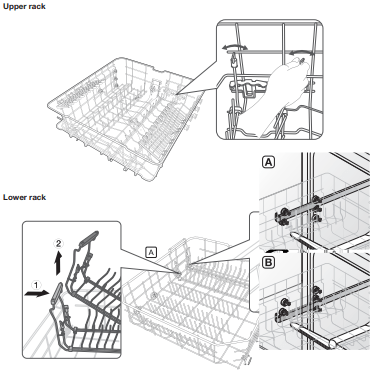
ADJUSTING THE HEIGHT OF THE UPPER RACK
You can adjust the height of the upper rack in your Samsung dishwasher so that the lower rack can accommodate larger sized dishes. Depending on where you set the upper rack height, the lower rack can accommodate plates up to 14 in. (36 cm) in diameter and the upper rack can accommodated plates up to 12 in. (30 cm) in diameter.
DW80M3021 Series
To adjust the height of the upper rack, follow these steps:
- Remove the upper rack following the directions in Removing the Upper Rack below.
- If you want to lower the upper rack, re-install the rack as shown in Figure A to the right.
- If you want to raise the upper rack, re-install the rack as shown in Figure B to the right.
 We recommend adjusting the height of the upper rack before loading dishes into the rack. If you adjust the the rack after loading the dishes, you may damage the dishes.
We recommend adjusting the height of the upper rack before loading dishes into the rack. If you adjust the the rack after loading the dishes, you may damage the dishes.
REMOVING THE UPPER RACK
Pull the upper rack towards the front and then remove it by lifting it up slightly and pulling it towards the front. See the illustrations below.
 While the upper rack is removable, it must be installed for the dishwasher to operate properly. If you attempt to operate the dishwasher without the rack, noise will occur and the dishwasher will perform poorly.
While the upper rack is removable, it must be installed for the dishwasher to operate properly. If you attempt to operate the dishwasher without the rack, noise will occur and the dishwasher will perform poorly.

LOADING THE LOWER RACK
Load cookware (pots, pans, etc.), up to 14 in. (36 cm) in diameter into the lower rack. The lower rack has been especially designed for dinner dishes, soup bowls, plates, pots, lids, casserole dishes, and plates. Load your plates into the center column of the rack so their open sides face towards the right. Load large items such as pans and pots into the dishwasher so their open sides face downwards. We recommend loading cups, stemware, and small plates into the upper rack.
See the recommended loading patterns below.
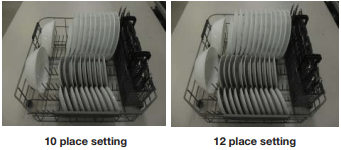
LOADING THE UPPER RACK
The upper rack has been designed for small plates, mugs, glasses, and plastic items marked “dishwasher safe”. Load your plates into the dishwasher so their open sides face each other.
Make sure the loaded dishes do not interfere with the rotation of the nozzle which is located at the bottom of the upper rack. (Check this by rotating the nozzle by hand.)
When loading dishes, pull the upper rack out sufficiently so you can load it without striking the counter above.
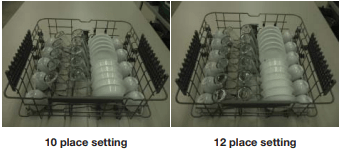
Using the glass support
You can load cups or glasses onto the glass support. This is also very convenient for washing wine glasses. Hang your wine glasses onto the pegs of the glass support.
You can fold the glass support back when it is not being used.
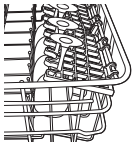
Loading the large items
You can load large items such as pans and pots into the lower rack.
Make sure pot handles and other items do not interfere with rotation of the nozzles.

USING THE CUTLERY RACK
The cutlery basket consists of two compartments.
You can place each knife, spoon, or fork separately into the spoon stands in the basket’s covers to prevent chipping and discoloration.
 DO NOT let any item extend through the bottom.
DO NOT let any item extend through the bottom.
| 1 Small forks 2 Spoons 3 Knives 4 Large spoons and forks See other models: SM-G988UZAASPR SR343LSTC QN65Q7FNAFXZC DVG54R7600C/A3 UN65RU7400FXZC 5 Medium-sized forks 6 Remaining items |
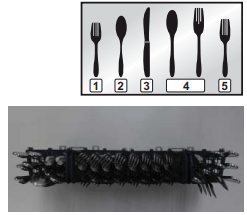 |
The spoon stands as seen from above with the suggested placement of cutlery items. Match the numbers in the diagram to the numbers in the list of cutlery items above.

You can use the cutlery basket with the cover open. Refer to the illustration to the right.
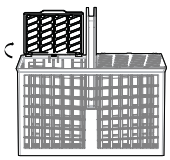
USING DETERGENT
All dishwasher cycles require detergent in the detergent compartment.
Add the correct amount of detergent for the selected cycle to ensure the best performance.
 Use dishwasher detergent only. Regular detergent produces too much foam, which may decrease the dishwasher’s performance or cause it to malfunction.
Use dishwasher detergent only. Regular detergent produces too much foam, which may decrease the dishwasher’s performance or cause it to malfunction.
 Do not swallow dishwasher detergent. Avoid breathing in the fumes. Dishwasher detergent contains irritants and caustic chemicals that can induce respiratory conditions. If you have swallowed dishwasher detergent or inhaled the fumes, seek medical attention immediately.
Do not swallow dishwasher detergent. Avoid breathing in the fumes. Dishwasher detergent contains irritants and caustic chemicals that can induce respiratory conditions. If you have swallowed dishwasher detergent or inhaled the fumes, seek medical attention immediately.
 Keep dishwasher detergent out of the reach of children.
Keep dishwasher detergent out of the reach of children.
Filling the detergent dispenser
1. Open the detergent dispenser flap by pushing the detergent dispenser release catch.
The flap is always open at the end of a dishwashing cycle.
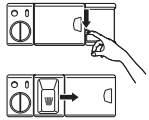
2. Add the recommended amount of detergent to the main wash detergent compartment.
3. Close the flap by sliding it to the left and then pressing it down.
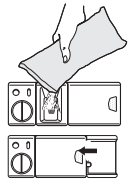
4. For better cleaning result, especially if you have very dirt items, pour a small amount (about 1/2 of an ounce or 15 g) of detergent onto the door.
The additional detergent will activate during the pre-wash phase.
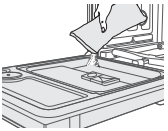
Filling the rinse aid reservoir
When the Rinse Refi ll indicator lights up on the control panel, refill the reservoir with rinse aid. Your dishwasher has been designed to use liquid rinse aid only.
Using a powdered rinse aid will clog the reservoir opening and cause the dishwasher to malfunction.
Rinse aid improves the drying performance of the dishwasher.
 Do not add regular detergent to the rinse aid reservoir.
Do not add regular detergent to the rinse aid reservoir.
1. Remove the rinse aid reservoir cap by rotating it counterclockwise.

2. Fill the rinse aid reservoir with rinse aid.
 Use the viewing port when filling the rinse aid reservoir.
Use the viewing port when filling the rinse aid reservoir.
 Do not fill the reservoir above the full level indicator. Excess rinse aid can overflow during the wash cycle.
Do not fill the reservoir above the full level indicator. Excess rinse aid can overflow during the wash cycle.

3. Turn the rinse aid indicator dial to a number between 1 and 6. The higher the number, the more rinse aid the dishwasher uses. If you are unable to rotate the rinse aid dial easily, try using a coin.

4. Close the rinse aid reservoir cap by rotating it clockwise.
Cleaning and maintaining your dishwasher
Keeping your dishwasher clean improves its performance, reduces unnecessary repairs, and lengthens its life.
CLEANING THE EXTERIOR
It’s best to clean spills on the outside of your dishwasher as they occur. Use a soft, damp cloth on the control panel to gently wipe away spills and dust. Do not use benzene, wax, thinner, chlorine bleach, or alcohol. These materials may discolor the inner walls and cause stains. Do not clean the dishwasher by sprinkling water over it and avoid letting water come into contact with any of the electrical parts.
 If your dishwasher has a stainless steel door panel, you can clean it with a stainless steel cleaner for home appliances or a similar product using a clean, soft cloth.
If your dishwasher has a stainless steel door panel, you can clean it with a stainless steel cleaner for home appliances or a similar product using a clean, soft cloth.
CLEANING THE INTERIOR
Clean the interior of your dishwasher periodically to remove any dirt or food particles. Wipe the inside of the dishwasher and the inner part of the door with a wet dishcloth. We recommend filling the detergent dispenser with dish detergent, and then running the dishwasher empty periodically using the Normal cycle with the sanitize option. This will keep your dishwasher clean.
If white spots and odor are still present in your dishwasher, run the Normal cycle with the dishwasher empty and without detergent until it flushes. Then, interrupt the cycle and put an 8 ounce cup of white vinegar into the lower basket. Close the dishwasher and let the cycle finish.
 Do not remove the tub front seal (the long rubber seal enclosing the opening of the dishwasher).
Do not remove the tub front seal (the long rubber seal enclosing the opening of the dishwasher).
CLEANING THE NOZZLES
If your dishwasher does not seem to be cleaning adequately or the nozzles seem clogged, you can clean each of the nozzles. When removing the nozzles, take care as they may break.
Lower nozzle
- Check whether the nozzle holes are clogged by food particles.
- If cleaning is needed, remove the nozzle by pulling it upwards.
- Clean the nozzle, and then push it back into place.
- Check whether the nozzle is engaged correctly by rotating it by hand.

Middle nozzle
- Pull the upper rack towards the front and remove it.
- Check whether the nozzle holes are clogged by food particles.
- If cleaning is needed, remove the nozzle.
- To remove the nozzle, unfasten and remove the nut, and then remove the nozzle.
- Clean the nozzle, re-insert it, and then fasten the nut.
- When fastening the nut, turn it firmly by hand.
- Check whether the nozzle is engaged correctly by rotating it by hand.
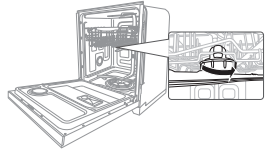
Upper nozzle
- Check whether the nozzle holes are clogged by food particles.
- If cleaning is needed, remove the nozzle.
- To remove the nozzle, pull out the upper rack first, unfasten the nozzle cap by turning it counterclockwise, and then remove the upper nozzle.
- Clean the nozzle, re-insert it, and then fasten the nozzle cap to the nozzle by turning the cap clockwise.
- Check whether the nozzle is engaged correctly by rotating it by hand.

Troubleshooting
CHECK THESE POINTS IF YOUR DISHWASHER…
| Problem | Possible cause | Solution |
| Will not start. | The door is not closed completely. |
Check if the door is latched and closed completely. Check whether the Upper Rack is properly joined with Duct Nozzle. Also, check if the Upper Rack is crooked or unbalanced.
|
| No cycle is selected. | Select a proper cycle. | |
| The power cable is not connected. | Connect the power cable properly. | |
| The water supply does not work. | Check if the water supply valve is open. | |
| The Control Panel is locked. | Unlock the Control Lock, (See page 8.) | |
| A circuit breaker is open. | Reset the circuit breaker. | |
| It’s taking too long with an operation or cycle. | The dishwasher is connected to a cold water supply | Check if the water supply line is connected to a hot water supply. To work properly, the dishwasher must be connected to a hot water supply. (If connected to a cold water supply, additional time is required to heat the cold water.) |
| There are food particles remaining on dishes. (Not cleaning properly.) | The cycle selected was unsuitable. | Select a cycle according to the number and soil level of the dishes, as directed in this manual. |
| The water temperature is low. | Connect the water supply line to a hot water supply. For best performance, the temperature of the supplied water should be 120 ˚F (49 ˚C). | |
| Low water pressure. | The water pressure should be between 20 and 120 psi (140-830 kPa). | |
| The water is too hard. |
Use a commercial dishwasher cleaner. Use high-quality, fresh detergent with rinse aid. Use a water softener additive designed for dishwashers. |
|
| Dishwasher detergent was not used. |
Use automatic dishwasher detergent. We recommend a powder or gel type dishwasher detergent. |
|
|
Detergent remains in the dispenser.
|
Make sure large items such as cookie sheets, cutting boards, or contaners, etc. are not blocking the detergent dispenser and preventing it from opening properly. Rearrange the dishes so they do not interfere with detergent dispenser operation. |
|
| There is no rinse aid. |
Check the dispenser and add rinse aid. Use liquid type rinse aid. |
|
| A nozzle is clogged. | Clean the nozzle. See pages 19 and 20. | |
|
The dishes are improperly loaded. Too many dishes have been loaded. |
Rearrange the dishes so they do not interfere with nozzle rotation and detergent dispenser operation. Load only an appropriate number of dishes. Load your dishes as recommended. (See pages 14 and 15.) |
|
| Leaves glasses with a light film. | The water supplied is soft and too much detergent was used. | Underload the dishwasher and use a rinse aid to minimize this. |
| Aluminum dishes were included in the wash load. | Remove the marks on the dishes using a low sensitivity cleaner. | |
| Leaves a yellow or brown film on the inside of the dishwasher. | This is caused by coffee and tea soils. | Remove the soils using a spot cleaner. |
| Does not dry dishes well. | There is no rinse aid in the dispenser. |
Check the dispenser and add rinse aid. Use a liquid type rinse aid. |
| The temperature of the water is low when the dishwasher is running. |
Connect the water supply line to a hot water supply. Use rinse aid with the Sanitize option. |
|
| Too many dishes have been loaded. |
Proper loading of items can affect drying. Load your dishes as recommended. (See pages 14 and 15.) |
|
| Glasses and cups with concave bottoms hold water. This water may spill onto other items when unloading. | After finishing the cycle, empty the lower rack first and then the upper rack. This will prevent water dripping from the upper rack onto the dishes in the lower rack. | |
| Has a bad odor. | Water was left over from an incomplete cycle. | Insert detergent without loading dishes, and run the Normal cycle to clean the dishwasher. |
| The Drain Hose is obstructed. | Contact a qualified service technician to remove any obstruction from the drain hose. | |
| The dishwasher is not used daily or soiled dishes are left in unit too long. | With the dishwasher empty and no detergent, place a glass with 8 ounces of vinegar upright into the lower rack, and then run a Normal cycle. | |
| Is too noisy | Sound is generated when the dispenser cover is open and the drain pump is operating in an early stage. | This is normal operation. |
| The dishwasher is not level. | Ensure the dishwasher is level. | |
| Foreign material (a screw, a plastic piece) is in the pump chamber. | Contact a qualified service technician to remove foreign material from the pump chamber. | |
| There is a ‘chopping’ sound because a nozzle is bumping against the dishes. | Rearrange the dishes. | |
| Does not have a smoothly rotating nozzle. | Nozzle holes are clogged with food particles. |
Clean the nozzle holes. See pages 19 and 20. |
| The nozzle is blocked by a dish or pot and cannot rotate. | After placing the dishes into the racks, rotate the nozzles by hand to check whether any of the dishes interfere with them. | |
| Has a bent upper rack after loading dishes. | The dishes are not loaded properly. |
Load your dishes as recommended. (See page 15.) |
INFORMATION CODES
The Control Panel displays information codes to help you understand what is occurring with your dishwasher.
| Code | Action |
| Code |
Over-level water check • Functional check. Close the water supply valve and go to your house circuit breaker panel, set the dishwasher’s circuit breaker switch to off, and then contact an authorized Samsung service center. |
| LC |
Leakage check • If a water supply valve connection leak occurs, close the water supply valve and go to your house circuit breaker panel, set the dishwasher’s circuit breaker switch to off, and then contact the installer to fi x. If the problem continues, contact an authorized Samsung service center. |
| 4C |
Water supply check • Check if the water supply valve is closed, the water supply is suspended, or the water inlet valve or line is frozen or clogged by foreign particles. If the problem continues, close the water supply valve, and then contact an authorized Samsung service center. |
| 5C |
Drain check • After closing the water supply valve, check whether the drain hose is clogged or folded. Also, check whether drain hole inside sump is clogged. If the problem continues, contact an authorized Samsung service center. |
| HC |
High temperature heating check • The product ensure that the temperature for hot water line is not too high and adjusts to appropriate temperature (120 ˚F (49 ˚C) - 149 ˚F (65 ˚C)) automatically. If the problem continues, go to your house circuit breaker panel, set the dishwasher’s circuit breaker switch to off , and then contact an authorized Samsung service center. |
| 3C |
Pump operation check • Functional check. Turn off the dishwasher and try to start it again. If the problem continues, contact an authorized Samsung service center. |
For any codes not listed above, call 1-800-SAMSUNG (726-7864).
 Control Lock indicator
Control Lock indicator Delay Start indicator
Delay Start indicator

